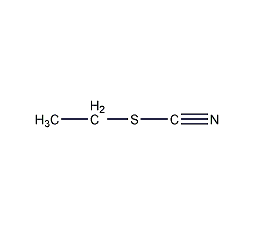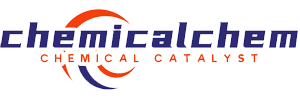
structural formula
| business number | 05lu |
|---|---|
| molecular formula | c3h5ns |
| molecular weight | 87.14 |
| label |
thiocyanato-ethane, thiocyanic acid ethyl ester |
numbering system
cas number:542-90-5
mdl number:mfcd00004820
einecs number:208-833-3
rtecs number:xk9900000
brn number:1737620
pubchem number:24858703
physical property data
1. character: light yellow liquid with onion smell[1]
2. melting point (℃): -85.5[2]
3. boiling point (℃): 146[3]
4. relative density (water=1): 1.01 (20℃) [4]
5. octanol/water partition coefficient: 1.22[5]
6. flash point (℃): 42.78 [6]
7. solubility: insoluble in water, miscible in ethanol and ether, soluble in chloroform. [7]
toxicological data
1. acute toxicity: rat oral ld50: 201mg/kg, behavior – lethargy (common depressive activity), dyspnea, lungs, chest or breathing – cyanosis;
rat dermal ldlo : 2512 mg/kg, behavior – drowsiness (common depressive activity);
rat subcutaneous ldlo: 40 mg/kg, behavior – drowsiness (common depressive activity), dyspnea, lung, chest or respiratory – cyanosis;
mouse intraperitoneal ld50: 10 mg/kg, peripheral nerves and sensations – flaccid paralysis without anesthesia (usually neuromuscular blockade), – convulsions or epilepsy, respiratory stimulation;
mouse subcutaneous ld50: 70 mg/kg, peripheral nerves and sensory – flaccid paralysis without anesthesia (usually neuromuscular blockade), – convulsions or epilepsy, respiratory stimulation;
mouse via intravenous ld50: 18mg/kg, no details other than lethal dose;
oral ldlo in cats: 10mg/kg, behavior – lethargy (common depressive activity) causing pulmonary, chest or respiratory or gastrointestinal changes ;
rabbit subcutaneous ldlo: 15mg/kg, behavior – convulsion or epilepsy, ataxia, muscle contraction or spasm;
2. other multiple dose toxicity data: rats oral tdlo: 804 mg/kg/2w-i, causing changes in the lungs, chest, breathing, and liver, changes in renal tubules and glomeruli;
3. acute toxicity[8] ld50: 40mg/kg (orally administered to mice)
4. irritation no information available
5. mutagenicity[9] microbial mutagenicity: salmonella typhimurium 100μg / dish.
ecological data
1. ecotoxicity no data available
2. biodegradability no data available
3 .non-biodegradable[10] in the air, when the concentration of hydroxyl radicals is 5.00×105/cm3, the degradation half-life is 2.2d (theoretical).
4. other harmful effects[11] this substance is harmful to the environment. special attention should be paid to the pollution of water bodies.
molecular structure number��
1. molar refractive index: 23.85
2. molar volume (cm3/mol): 85.4
3. isotonic specific volume (90.2k ): 210.4
4. surface tension (dyne/cm): 36.8
5. polarizability (10-24cm3): 9.45
compute chemical data
1. reference value for hydrophobic parameter calculation (xlogp): 1.3
2. number of hydrogen bond donors: 0
3. number of hydrogen bond acceptors: 2
4. number of rotatable chemical bonds: 1
5. number of tautomers: none
6. topological molecule polar surface area 49.1
7. number of heavy atoms: 5
8. surface charge: 0
9. complexity: 51.2
10. number of isotope atoms: 0
11. determine the number of atomic stereocenters: 0
12. uncertain number of atomic stereocenters: 0
13. determine the number of chemical bond stereocenters: 0
14. number of uncertain chemical bond stereocenters: 0
15. number of covalent bond units: 1
properties and stability
1. stability[12] stable
2. incompatible substances [13] strong oxidants, strong reducing agents, strong acids
3. conditions to avoid contact[14 ] heating
4. polymerization hazard[15] no polymerization
5. decomposition products[16] sulfide, hydrogen cyanide
storage method
storage precautions[17] store in a cool, dry and well-ventilated warehouse. keep away from fire and heat sources. the storage temperature does not exceed 35°c and the relative humidity does not exceed 85%. the packaging must be sealed and must not come into contact with air. should be used with oxidizing agents. store reducing agents, acids, and food chemicals separately, and avoid mixed storage. use explosion-proof lighting and ventilation facilities. it is prohibited to use mechanical equipment and tools that are prone to sparks. the storage area should be equipped with emergency release equipment and suitable containment materials.
synthesis method
purpose
used as insecticides, fungicides, and intermediates. [18]

 微信扫一扫打赏
微信扫一扫打赏

